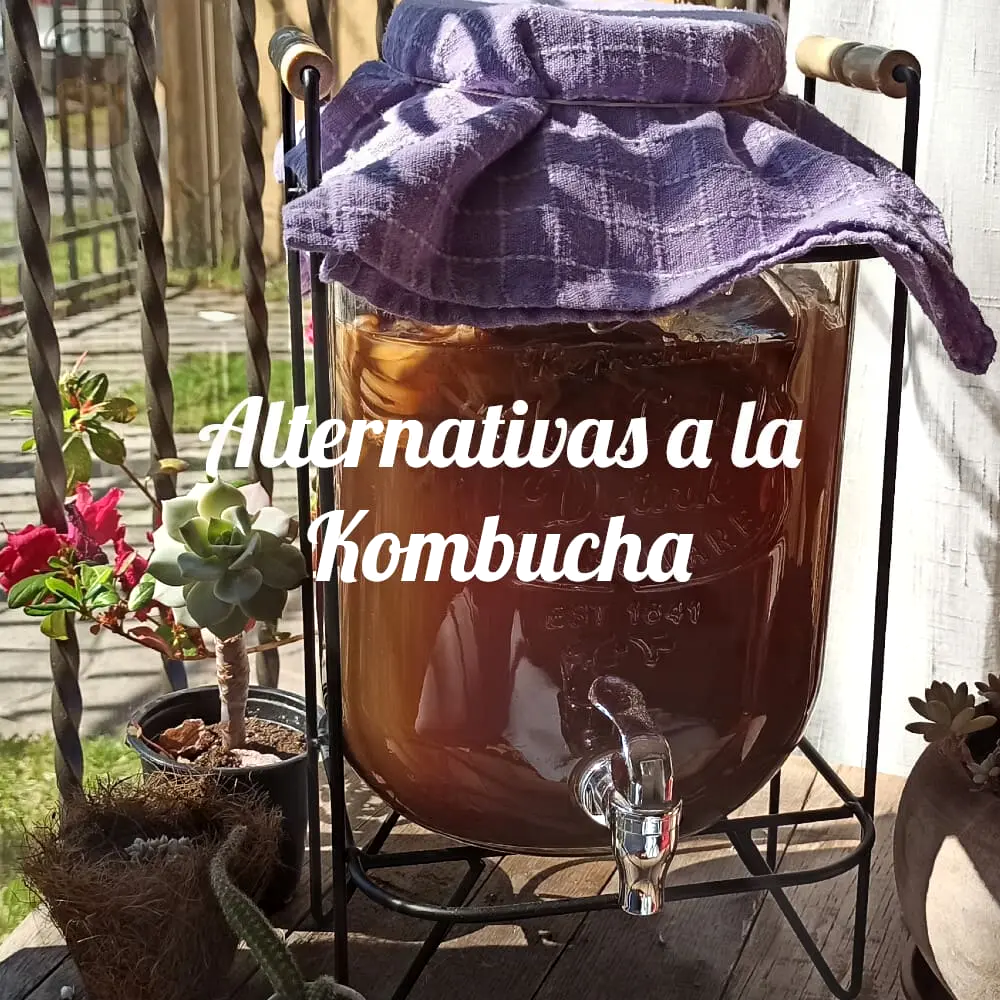Kombucha is a drink quite rich in flavor (at least for me). Still, we have already spoken on some occasions that many people feel displeasure when drinking it. Additionally, it is a drink not recommended for people suffering from gastroesophageal reflux, as seen in the article about kombucha and heartburn.
Regardless of the reason, there is often a need to find a replacement with the same characteristics and health benefits as kombucha. In that aspect, there are a variety of probiotic fermented foods with similar features and health effects, and we will talk in detail about them.
Contents
Jun
It is a fermented beverage with a remarkable similarity with kombucha tea, differing only in the initial ingredients and some microbial strains during fermentation. It is prepared with green tea and raw honey instead of black tea and cane sugar, as in kombucha. It also needs a SCOBY culture to ferment, so they are considered sister drinks.
Jun has a slightly more acidic taste but has the same probiotic properties as kombucha. It can be carbonated in a second fermentation and shows many therapeutic and preventive health benefits.
The drink may manifest some health benefits that raw honey and green tea give as antioxidant properties, as well as an antimicrobial effect that could help counteract certain viral, bacterial, or mycotic infections.
Another aspect where it is compared to kombucha is its high content in complex B, which also intervenes in the psychic state of the person improving mental clarity and emotional well-being.
It has possible benefits to the liver, digestive, intestinal, and joint health; the drink can stimulate the immune system, calm the nerves, relieve pain, and stabilize blood pressure.
In addition, it is mentioned that it can work as a natural antihistamine if consumed daily, thus helping to control allergies.
You can check the comparison between Kombucha and Jun here.
Kefir
It is a fermented milk drink with a distinctive and slightly effervescent flavor presented at the end of fermentation with a high nutritional content, low in fat, and somewhat acidic taste.
It is prepared by inoculating milk with kefir grains that would be the equivalent of the SCOBY culture used in kombucha; these grains are composed of a variety of microorganisms highlighting lactic acid (BAL) and acetic acid (BAC) bacteria that will form organic acids that will slightly increase the acidity of milk.
Because of this, kefir, like kombucha, can improve digestion, present antibacterial effects due to low pH, modify the internecine microbiome, and some claim other health benefits such as antihypertensive, anti-inflammatory, anticancer, and antiallergenic effects.
It can control plasma glucose and cholesterol levels, as well as favor the immune system in defense against pathogens.
Also, the BAL will significantly reduce the lactose content to produce lactic acid, making it suitable for the consumption of lactose intolerant and healthy for diabetics, as well as being useful for the conservation of the product.
Kefir can continue to ferment after preparation to produce other kombucha-like compounds such as ethanol, CO2, and B vitamins. [1] [2]
You can check the comparison between Kombucha and Kefir here.
Rejuvelac
You can use sprouted grains to make fermented beverages. One of the most popular is Rejuvelac, prepared with quinoa grains
or sprouted wheat, showing a probiotic effect that maintains the proper functioning of the digestive system. [3]
It is prepared by fermenting the grains in water at room temperature and without oxygen. Among the microorganisms present is a good content of BAL, highlighting lactobacillus bifidus, producing certain bacteriocins that give antifungal properties to the drink.
Among the benefits of Rejuvelac to digestion are a rapid absorption of nutrients after consumption, cleansing of the colon (removing sediment from its walls), and the contribution of beneficial bacteria to the gastrointestinal tract.
In this way, it helps heal intestinal problems, prevent diseases, and intervene in stomach health.
Many of these features we just mentioned are comparable to the benefits kombucha displays, not to say that Rejuvelac is also a good source of vitamins B, E, and K.
There are more uses of Rejuvelc, such as serving as a base for preparing vegan cheeses and juices and reducing peanut allergens by fermenting it with Rejuvelac making it edible for some consumers. [4]
You can check the comparison between Kombucha and Rejuvelac here.
Ginger beer
It is a carbonated drink with a ginger flavor that is fermented traditionally, offering healthy microorganisms and a good amount of carbohydrates, proteins, vitamins, and minerals.
As inputs require carbonated water, sugar, fresh ginger, or any commercial product of ginger, yeast, preservatives, citric and ascorbic acid, obtaining a drink that manifests the health benefits of ginger.
It is fermented using the microorganisms naturally present in ginger or by directly adding Saccharomyces cerevisiae while closely monitoring the process. Subsequent sterilization will not be necessary to protect the drink since, like kombucha, it produces many organic acids and alcohols that prevent the colonization of other microorganisms.
In this way, it prevents the product’s decomposition and promotes consumers’ well-being. Ginger beer also shows the same antioxidant, anti-inflammatory and analgesic properties, as well as helping to manage high cholesterol, diabetes, the common cold, headache, and toothache. [5] [6]
You can check the comparison between Kombucha and Ginger Beer here.
Miso
Miso is a soybean paste fermented in two stages (up to 2 years) with a characteristic flavor and aroma. It is a traditional food in Japanese cuisine used as the main condiment to make miso soup. It shares with kombucha anti-inflammatory, antidiabetic and antioxidant effects. [7]
It provides a high content of isoflavones, proteins, and minerals, highlighting potassium that could be beneficial to reduce blood pressure and strokes and associated with lower mortality risk. [8]
It has been suggested in other studies that kombucha may promote an increase in HDL, which is beneficial against heart disease (although this has only been proven in animals). [9]
Apparently, with miso, there is also this possibility since it has a higher content of unsaturated fatty acids (good fats) and a lower content of saturated fatty acids (bad fats), increasing the availability of HDL in plasma which has a preventive effect against cardiovascular diseases. [10]
More frequent miso consumption is associated with reduced gastroesophageal reflux disease (GERD) symptoms.
Sauerkraut
It is a highly nutritious fermented cabbage food with a high lactic acid content allowing a pH low enough to preserve the food reducing the risk of contamination, and being a good contribution of healthy microorganisms for the gastrointestinal system. [11]
Sauerkraut has a high content of vitamins and minerals, being a good source of ascorbic acid or vitamin C if fermented well. Despite that, it is a high-fiber, low-calorie food. [12]
If sauerkraut is consumed daily in small doses of 7 to 10 grams a day, it will provide microorganisms that will contribute to intestinal flora, improving digestion and preventing constipation.
While its health benefits have been demonstrated, you should be cautious about consuming it as unwanted effects or allergic reactions were observed in susceptible people such as patients with depression or allergy problems.
Another aspect to mention is its effect on depression and anxiety due to the presence of monoamine oxidase inhibitors (MAOIs), also intervening in controlling obsessive-compulsive disorders and Parkinson’s disease.
You can check the comparison between Kombucha and Sauerkraut here.
Kimchi
It is a traditional and popular dish in Korea prepared from the fermentation of baechu cabbage and different ingredients (mainly a variety of vegetables) to give it flavor, texture and increase its nutritional value, showing health benefits such as probiotic, anti-inflammatory, antibacterial, and antioxidant properties. [13]
Several of its health effects resemble kombucha. In addition to those already mentioned, kimchi shows cholesterol-lowering results and the ability to decrease weight gain, in addition to having potential anti-aging properties.
Kimchi also contains LAB as the most dominant in fermentation, transforming the ingredients into substances that help eradicate putrefactive and pathogenic bacteria that can impair the durability of the food, in addition to generating a variety of flavors and aromas at the end of fermentation. [14]
You can check the comparison between Kombucha and Kimchi here or see the comparison between Sauerkraut and Kimchi.
Tempeh
It is a fermented soy food from Indonesia with a high protein content, isoflavones, and aglycones. Its preparation consists of peeling, cooking, and adding the culture to ferment the soybeans. It can be consumed fried, boiled, steamed, or roasted.
Tempeh during fermentation presents changes in its chemical and nutritional composition leading to differences in flavor, aroma, and its potential effect on health. It has in common with kombucha a possible preventive impact against diarrhea and chronic diseases.
Part of these benefits are due to its high content of B vitamins. In addition, tempeh also reduces the carbohydrate content during fermentation; in this way, it can help reduce flatulence since it degrades complex sugars into more digestible sugars. [15] [16]
[1] https://www.mdpi.com/2306-5710/7/3/48/htm
[2] https://www.cambridge.org/core/journals/nutrition-research-reviews/article/milk-kefir-nutritional-microbiologic-and-health-benefits/1393DC2B8E5F08B0BE7BD58F030D387B
[3] https://www.sciencedirect.com/science/article/abs/pii/S1878450X21000743
[4] https://www.ncbi.nlm.nih.gov/pmc/articles/PMC7146175/
[5] https://www.mdpi.com/2311-5637/6/4/102/htm
[6] https://ir.library.oregonstate.edu/concern/honors_college_theses/73666b11h
[7] https://ift.onlinelibrary.wiley.com/doi/full/10.1111/1750-3841.15773
[8] https://www.ncbi.nlm.nih.gov/pmc/articles/PMC7461326/
[9] https://pubmed.ncbi.nlm.nih.gov/22591682/
[10] https://www.ncbi.nlm.nih.gov/pmc/articles/PMC6483656/
[11] https://www.ncbi.nlm.nih.gov/pmc/articles/PMC4268643/
[12] https://www.sciencedirect.com/science/article/abs/pii/S0065262808601391
[13] https://pubmed.ncbi.nlm.nih.gov/27733844/
[14] https://pubmed.ncbi.nlm.nih.gov/24419800/
[15] https://ift.onlinelibrary.wiley.com/doi/abs/10.1111/1541-4337.12710
[16] https://www.scielo.br/j/cta/a/LB7W5cg7hsrmLNvwXxhdVJh/?lang=en&format=html

